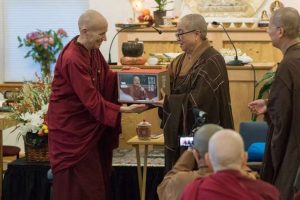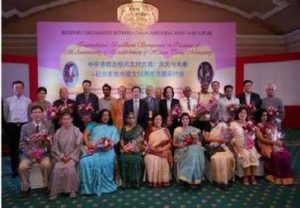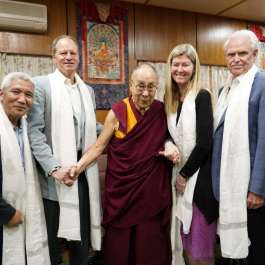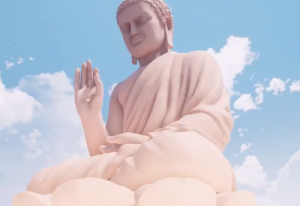All that we know about a buddha was spoken by Shakyamuni
If we are honest with ourselves, we understand very little about the true nature of a buddha. All our knowledge about Buddhism originates from the sutras spoken by Shakyamuni Buddha, who was born in ancient India about 2,600 years ago. Through the tools of human language and concepts, he taught us about the category of the buddha in ways that sometimes push the human imagination and intellect to their limits.
However, we should note that what Shakyamuni Buddha taught us about the world is true. For instance, he said: “In our world, all phenomena are impermanent.” Is it true? Can we find one single instance of physical matter, including our bodies, or even one single thought in our mind, that persists in a permanent state or never changes with time?
Shakyamuni Buddha also tells us: “A thing changes because other things change; all phenomena are interdependent and interrelated and none of them have their own existence without being affected by other factors.” Is this true? If we think deeply and perceive thoroughly, we will see that all phenomena arise together as part of an intricate web of interconnection.
Shakyamuni Buddha says in the Diamond Sutra: “The Tathagatas’ words are true and correspond to reality. They are ultimate words, neither deceitful nor heterodox.” This is an important statement to all Buddhists. We should remember that all sutras start with “Thus have I heard,” which means we should believe what we hear and read in the sutras.
Here is another truth taught to us by Shakyamuni Buddha: nirvana. This concept indicates full, existential, permanent liberation in Buddhism. Nirvana is a Sanskrit word that means no birth and no death. It corresponds to a state of stillness in which the concepts of space (motion) and time (change) are fully transcended. But really, it is beyond the capacities of ordinary beings to understand nirvana. Only buddhas can understand.
When Shakyamuni Buddha passed away at the age of 80, he said in the Nirvana Sutra that he would “return” to the state of Nirvana, where he would enjoy eternal joy and total emancipation in his Reward Land called “Invincible.” In Buddhism, the eternal joy and emancipation of life is to become a Buddha.
Every Buddha has his own reward land, which is formed and adorned by the merits and virtues attained through accomplishing his individual vows and bodhisattva practices. Of course, these vows and practices are for delivering sentient beings in the ten directions. A buddha’s reward land is buddha-land, also known as a pure land.
That Amitabha Buddha exists was also spoken by Shakyamuni Buddha
Shakyamuni Buddha says in the Amitabha Sutra: “If you travel westward from here, passing a hundred thousand kotis of buddha-lands, you come to the land called Bliss, where there is a buddha named Amitabha. He is living there now teaching Dharma.” So, the Land of Bliss is Amitabha’s Reward Land.
The Sutra of Common Nature of Mahayana says those who become buddhas in a reward land such as the Land of Bliss are called Reward Buddhas. They are like Amitabha, while those who become buddhas in the manifested land, such as the Land of Saha, are called Manifested Buddhas. They are like Shakyamuni.
All buddhas attain perfect enlightenment and have realized the threefold body, namely, the Dharma body, the reward body, and the manifested body. In the Dharma body, all buddhas attain unity, equality, and sameness. The Dharma body permeates the trichiliocosm, or the entire Dharma Realm, in all the boundless and immeasurable planes of existence.
However, since all buddhas have their own individual vows and bodhisattva practices to deliver sentient beings in the ten directions in the causal ground, their reward lands resulting from the accomplishment of vows and practices are not the same. Thus, the benefits bestowed on all sentient beings in the ten directions are different.
For instance, Amitabha Buddha set forth the great vow of “rebirth through name-recitation” in his causal ground when he was Bodhisattva Dharmakara: “Even ten times; should they not to be reborn, I will not attain perfect enlightenment.” This means that, upon becoming a buddha, he must have accomplished his great vow.
By achieving buddhahood, Amitabha must have accomplished the buddha-land to which all sentient beings can aspire to be reborn. He must have also accomplished the name that sentient beings recite and thus attain rebirth in his buddha-land. These things must happen at the same time, otherwise he cannot become Amitabha Buddha.
Shakyamuni’s body is different from Amitabha’s body in ways we cannot see
Shakyamuni Buddha achieved buddhahood when he was 35. His body appeared in human form, which is known as a Manifested Body. However, what did Amitabha’s body look like when he became a buddha 10 eons ago dwelling in his Reward Land, the Land of Bliss? Let’s see how Shakyamuni Buddha described the true Reward Body of Amitabha Buddha in the Ninth Contemplation in the Contemplation Sutra, as follows:
“The Buddha Amitayus (the other name of Amitabha Buddha) possesses eighty-four thousand physical characteristics, each having eighty-four thousand secondary marks of excellence. Each secondary mark emits eighty-four thousand rays of light; each light shining universally upon the lands of the ten quarters, embracing, and not forsaking, those who are mindful of the Buddha.”
In other words, the body of Amitabha Buddha is in the form of light permeating the entire Dharma Realm, including all sentient beings in the ten directions. Amitabha’s “light body” that we cannot see is different from Shakyamuni Buddha’s human body that we can see.
Whoever is mindful of, or recites Amitabha’s Name, will be embraced and protected, without being forsaken by his light. That means that Amitabha Buddha’s “mind light” can enter the minds of those sentient beings who are mindful of him or recite his Name. As a result, Amitabha Buddha can benefit them, protect them, and deliver them.
Unlike Shakyamuni Buddha, Amitabha Buddha takes the form of light shining universally upon the lands of the directions without obstruction. Moreover, their ways of delivering sentient beings are different. Let’s discuss this further in the next article.
Related features from BDG
Buddhism is a Path that Leads Us to Become a Buddha
The Deep and Broad Meaning of Rebirth in the Pure Land
How Many Kinds of Living Beings Are There in the Land of Bliss?














